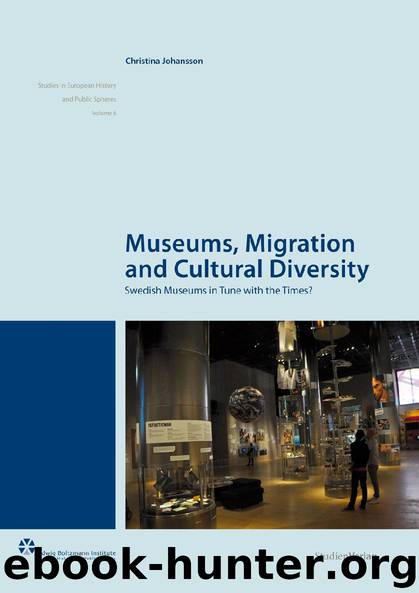Museums, Migration and Cultural Diversity by Christina Johansson

Author:Christina Johansson
Language: deu
Format: epub
Publisher: StudienVerlag
Published: 2015-02-26T00:00:00+00:00
Which Voices Are Heard in the Museum’s Collaborative Projects?
Even though in general Clifford has a positive view of the collaborative attempts made by museums, he also highlights the problem of unequal power relations within “contact zones”. In the following section we will take a closer look at this specific problem and how it might affect the possibility of taking part in the project.
First, it should be noted that the museum intended to give voice to and collaborate with people who had arrived in Sweden as labor immigrants. It was, according to the curator, logical for a museum of work to highlight this particular form of migration (The Museum of Work 2008b). However, as the different local projects progressed, it proved difficult to maintain the distinction between labor migration and other kinds of migration. Even though the general focus was on labor immigration, some of the projects homed in on a kind of migration that in other contexts would have been categorized as refugee migration. Obvious examples are narratives about refugees produced by the Second World War and those about Chilean, Assyrian/Syrian and Bosnian refugees. This shows that in reality it is difficult to make use of distinctions that are administratively created to separate one migration phenomenon from another. However, as planned, the bulk of the stories focused on labor immigrants who had arrived in Sweden between the Second World War and the 1970s.
Second, the way the museum chose to organize the project meant that it was mainly immigrants organized in immigrant associations who were given a voice. According to the curator managing the project at the Museum of Work, the museum contacted the local museums and left it to them to involve educational associations and immigrant associations. Generally, each local project was led by a representative from a local museum, although in some cases representatives from either an educational association or immigrant association were assigned this role. Furthermore, according to the curator it was the largest immigrant association in each place that became central in the projects (The Museum of Work 2008a, 2008b). The fact that the Museum of Work chose to work with immigrant associations, and the curator’s view that the largest immigrant association at each place became important, revealed the value of being organized as an immigrant association. This should not only be regarded as something particular to how the Museum of Work chose to act, but also as part of general Swedish organizational structure. Through state funding and social engineering, immigrants in Sweden have organized themselves in associations that primarily correspond to national and ethnic identities. It can thus be said that the state supports the construction of ethnically based associations (Schierup 1991).
Third, it mainly seems as though people who took the initiative had their voices heard. When discussing who was given the opportunity to tell their story, one representative of an educational association said that “narrative cafés” had been arranged so that people could come and share their stories. On those occasions people from several countries
Download
This site does not store any files on its server. We only index and link to content provided by other sites. Please contact the content providers to delete copyright contents if any and email us, we'll remove relevant links or contents immediately.
The Secret History by Donna Tartt(18160)
Red Sparrow by Jason Matthews(5195)
Harry Potter 02 & The Chamber Of Secrets (Illustrated) by J.K. Rowling(3555)
In a Sunburned Country by Bill Bryson(3366)
Drawing Cutting Edge Anatomy by Christopher Hart(3290)
Figure Drawing for Artists by Steve Huston(3268)
The Daily Stoic by Holiday Ryan & Hanselman Stephen(3109)
Harry Potter and the Prisoner of Azkaban (Book 3) by J. K. Rowling(3109)
Japanese Design by Patricia J. Graham(3000)
The Roots of Romanticism (Second Edition) by Berlin Isaiah Hardy Henry Gray John(2819)
Make Comics Like the Pros by Greg Pak(2757)
Stacked Decks by The Rotenberg Collection(2685)
Harry Potter and the Deathly Hallows (7) by J.K. Rowling(2550)
Draw-A-Saurus by James Silvani(2503)
Tattoo Art by Doralba Picerno(2484)
On Photography by Susan Sontag(2482)
Foreign Devils on the Silk Road: The Search for the Lost Treasures of Central Asia by Peter Hopkirk(2386)
Churchill by Paul Johnson(2362)
The Daily Stoic by Ryan Holiday & Stephen Hanselman(2343)
